#write it wednesday
Explore tagged Tumblr posts
Text

#wednesdays full of woe#dark academia#light academia#books#academic libraries#dark acadamia aesthetic#spilled ink#halloween#halloween vibes#horror#quotes#poems#poetry#literature#August#September#summer#autumn#cottagecore#dark academia moodboard#spilled thoughts#spilled words#poemsdaily#poems on tumblr#spilled poetry#spilled writing#studybrl#poetsandwriters#poets on tumblr#autumn moodboard
6K notes
·
View notes
Text

Pull out those journals!
#mentalhealth #journalentry #journalprompts #journaling #journaltopic #writeitout #writingprompt #writingtopic #writerscommunity #love #humpday #humpdayvibes #writingcommunity #Wednesday #sad #depression
#mental health#pulseincorp#mental health medics#positive mental attitude#pulseinc#crisis help#peer support#journal topic#journal prompts#journal enteries#journals#journal entry#write it wednesday#wednesday#writing prompt#writing topics#writing prompts#writing tools#writing#writers community
0 notes
Text

idk if this has been done but
#for all my writers out there#fanfic#writing#writing fanfic#wip#wip wednesday#this is all I have to show
19K notes
·
View notes
Text
Creating Fear in Your Characters: A Writers Guide

Creating authentic emotions is vital for immersive storytelling, which is why I decided to make this series on how to write different emotions. After exploring rage, and sadness it's now time to delve into fear!
Fear is a powerful emotion that can manifest in various ways, from subtle apprehension to paralyzing terror. Here's a guide on how to write fear effectively, covering different aspects of your characters' behavior and reactions.
Facial Expressions
Fear often manifests first in facial expressions, conveying the initial shock or unease. Describe these expressions to immerse readers in your character's emotional state:
Widened Eyes and Dilated Pupils: Show the eyes widening in response to a sudden threat, with dilated pupils indicating heightened alertness.
Tense Jaw and Clenched Teeth: Mention the clenching of jaw muscles or teeth, signaling internalized stress or anxiety.
Furrowed Brow and Raised Eyebrows: Describe the furrowing of the forehead and raised eyebrows, revealing worry or confusion.
Quivering Lips or Lip Biting: Note subtle lip movements like quivering or biting, reflecting nervousness or fear.
Frozen or Stiff Facial Muscles: Highlight moments of fear-induced immobility, where facial muscles become tense and rigid.
Body Language and Gestures
Fear can also be expressed through body language and gestures, showcasing your character's instinctual responses to danger or threat:
Backing Away or Recoiling: Describe your character instinctively moving backward or recoiling from the source of fear, signaling a desire to retreat.
Raised Shoulders and Tensed Posture: Show how fear causes the shoulders to rise and the body to tense up, indicating readiness for fight or flight.
Trembling Hands or Shaking Limbs: Mention the trembling of hands or shaking of limbs, reflecting nervousness or anxiety.
Covering Vulnerable Areas: Describe your character instinctively covering vulnerable areas like their neck or torso, symbolizing a protective gesture.
Fidgeting or Restlessness: Note any fidgeting or restlessness, such as tapping feet or wringing hands, as signs of inner turmoil and fear.
Vocal Cues and Dialogue
Fear can alter vocal cues and dialogue, affecting how your character speaks and communicates their emotions:
Quavering Voice or Shaky Speech: Describe the voice quivering or becoming shaky, indicating nervousness or fear.
Rapid Breathing and Gasping: Mention rapid breathing or gasping for air, showcasing the physical impact of fear on the respiratory system.
Stammering or Hesitant Speech: Note any stammering or hesitant speech patterns, reflecting the character's struggle to articulate their thoughts coherently.
Sudden Silence or Lack of Verbal Response: Show moments of sudden silence or the inability to respond verbally, highlighting the overwhelming nature of fear.
Repetitive Phrases or Vocalizations: Describe repetitive phrases or vocalizations, such as muttering prayers or chanting reassurances, as coping mechanisms in fearful situations.
Reactions and Physical Responses
Fear triggers various physical responses in your characters, showcasing the body's instinctual reactions to perceived threats:
Increased Heart Rate and Sweating: Mention the character's heart rate increasing and sweating profusely, reflecting heightened physiological arousal.
Dilated Pupils and Heightened Senses: Describe dilated pupils and heightened sensory perception, as the character's senses become more attuned to potential dangers.
Muscle Tension and Rigidity: Note muscle tension and rigidity, as the body prepares for action or defense in response to fear.
Nausea or Stomach Churning: Show how fear can lead to feelings of nausea or stomach churning, as the body's stress response impacts digestive functions.
Fight, Flight, or Freeze Response: Highlight the character's instinctual response to fear, whether it's a readiness to fight, a desire to flee, or a state of frozen immobility.
Types of Fear and Emotional Depth
Different types of fear can evoke varying emotional responses in your characters, adding depth to their portrayal and the narrative:
Startle Fear: Describe the sudden, reflexive fear triggered by unexpected events or loud noises, leading to a quick, intense reaction.
Apprehensive Fear: Show the lingering sense of unease or dread that accompanies anticipated threats or impending danger, heightening tension over time.
Terror: Depict the overwhelming, paralyzing fear that arises from extreme danger or horrifying experiences, impacting the character's ability to think or act rationally.
Phobias: Explore specific phobias that trigger irrational and intense fear responses, shaping how your character navigates their environment and interactions.
Trauma-Induced Fear: Address fear resulting from past traumas or experiences, influencing the character's behavior and emotional resilience in present situations.
Verbs and Adjectives for Writing Fear
Here's a list of verbs and adjectives to help you convey fear effectively in your writing:
Verbs: tremble, cower, gasp, quiver, shrink, freeze, recoil, sweat, pant, gulp, shudder
Adjectives: terrified, anxious, alarmed, horrified, shaken, jittery, panicked, petrified
#quillology with haya#hayatheauthor#haya's book blog#haya blogs#writers on tumblr#writer community#writing fear#writer tools#scary stories#writer blog#writer stuff#writer wednesday#writer tips#creative writing#writing emotion#writers of tumblr#writerscommunity#writeblr#writing community#writer spotlight#writer things#writing prompt#writing tools#writing stuff#writing#writing life#writing inspo#writing help#writing advice
2K notes
·
View notes
Note
Wednesday Addams x F!Reader
• Reader is about to leave for work. Wednesday asks her if she's forgotten anything, and Reader gives her a kiss. Wednesday turns red and opens her hand to reveal Reader's keys/wallet/etc., saying
'I meant this, but it's appreciated.' Or smt like that!
forgetting something ?

Pairing: Wednesday Addams X fem!reader
Words: 4k
Warning: fluffy
Author notes: I've received a lot of requests, I'll try to do them all!
Happy reading
"Love, what's the password for your phone?" I ask curiously as my eyes glance at the smartphone in my hand.
I found myself in Ophelia Hall in Wednesday's room with Enid, wanting to spend some time with my girlfriend. Enid was doing Things' manicure while sharing some gossip about some outcasts at school. Meanwhile, Wednesday Addams was making the most of her writing time.
Ignoring me.
The tapping of the keyboard abruptly ceases and Wednesday slowly turns towards me. Her brown eyes turn cold and dark as they meet Enid's, who visibly trembles in the face of that icy, penetrating intensity.
"Things, I'll finish later..." Enid whispers, her nervous smile betraying the fear inspired by Wednesday's gaze.
Without saying another word, Enid jumps up from her bed and hastily exits the room. The door slams behind her, resonating in the silent air as Wednesday watches her pass with an impassive expression, lips pressed in a subtle smile of satisfaction.
"How many times have I told you not to scare her?" I say with a small smile on my lips, and Wednesday looks at me without batting an eyelid.
"I didn't scare her," her voice is calm and controlled, without any hint of remorse or concern.
"You did," I sigh at her comment while absentmindedly playing with her phone.
"As you wish," Wednesday replies calmly, showing no particular emotion.
I smile shyly at her response.
"I told you not to use vulgar nicknames in front of others and you keep doing it," Wednesday justifies herself, looking at me curiously.
I raise an eyebrow in confusion.
"Vulgar?" I ask, feeling puzzled.
Wednesday nods timidly, without a hint of a smile on her lips.
I sigh loudly.
"Anyway... Could you tell me the password?" I ask again, wanting to change the subject to avoid ruining the atmosphere.
Wednesday tilts her head to the side and scrutinizes me with her gaze.
We've been together for a month, but I don't know if I'll ever get used to her quirks.
"My favorite plant" Wednesday replies in a monotone voice.
"Of course" I reply sarcastically as I type in 'Belladonna.' The phone unlocks, and I smile as I see the background: me and Wednesday embracing during the Poe Cup. The brunette had a stoic look while she look at me smile at the camera.
"Nice background," I say teasingly and Wednesday rolls her eyes at my comment.
"I know," she replies monotone.
I could see a small smile threatening to emerge at any moment.
"But don't you have any games?" I ask disappointedly, and Wednesday stares intensely at me.
"I barely use it to write to you," she justifies herself, and I nod understandably.
Wednesday and technology were two completely different things and couldn't fit in the same sentence.
"So you only have WhatsApp?" I ask curiously, looking at Wednesday.
"You're distracting me unnecessarily," Wednesday mutters annoyed by my questions. She turns her back on me and starts writing her story again.
"Thanks, Wed" I say sarcastically, and Wednesday continues to press the keys of the typewriter ignoring me.
"Why am I with her, I don't know," I mutter to myself, turning my gaze to her phone. I scroll through some pages and look at the apps.
I choice YouTube.
"Because you love me," Wednesday replies loudly without looking at me "and anyway, I can hear you, be careful," she adds in a cold voice.
Was that a threat?
"Right" I reply aloud.
I start searching for what interests my girlfriend. Hundreds of horror stories and interviews of real murders, true photos, and thousands of hypotheses about monsters, unsolved murders, and much more.
Creepy but Wednesday's style.
"Y/n?" I raise my head from the phone and turn my attention to Wednesday who had once again interrupted her writing hour.
"Tell me, darling" I ask with a smile on my lips.
"Shouldn't you be going to work at the café?" Wednesday asks with curiosity.
My smile fades and I widen my eyes in realization: I had forgotten.
I quickly get up from the bed in a panic
"shit shit" I put on my shoes and look around the room in concern. "Where's the jacket?" I wonder, and I look around the room with worry. "You threw it on Enid's bed," Wednesday exclaims disapprovingly, and I smile hugely.
I internally thank Wednesday for her incredible memory.
I walk towards the door, but Wednesday's voice makes me stop.
"Forgetting something?" She asks seriously.
I sigh at the unfortunate moment of being romantic. "You're right" I walk towards her and lean down towards her face to unite our lips in a sweet kiss.
As we separate, I notice that Wednesday's cheeks were completely flushed.
"You were forgetting the car keys, idiot," says Wednesday embarrassed, showing me the keys.
I had left them on her desk an hour ago when I arrived.
"Oh, thanks," I say embarrassed, and Wednesday smiles widely making my heart race a mile a minute.
"But I appreciated it" she confesses quickly and I smile back getting lost in her deep brown eyes.
Yes, definitely, now I remember why I'm with her.
#jenna ortega x reader#jenna ortega#jenna ortega x you#jenna ortega x y/n#jenna ortega x fem!reader#wednesday addams x reader#wednesday x you#wednesday smut#wednesday addams gifs#Fluffy#writing requests#wednesday fanfic#wednesday adams x reader#wednesday addams x you#wednesday addams#wednesday x reader#wednesday x y/n#Wed
3K notes
·
View notes
Text
What is...
On every What is Wednesdays I will explain a trope, a rhetorical device, or a literary technique in a few sentences. Put in the comments what you would like me to explain next.
What is... a drabble?
What is... dead dove?
What is... archetypal characters?
What is… deus ex machina?
What is… whump?
What is... plot bunny?
What is... canon vs. fanon?
What is… a headcanon?
What is… a plot hole?
What is… retcon?
What is… WIP?
What is… a sequel hook?
What is… a crossover?
What is… crack?
What is… a rarepair?
What is… a red herring?
What is… fluff?
What is… smut?
What is… OOC?
What is… a missing scene?
What is… Coda?
What is… a trope?
What is… Alpha vs. Beta Reader?
What is… a cliffhanger?
If you like my blog and want to support me, you can buy me a coffee or become a member! And check out my Instagram! 🥰
#what is wednesday#writing#writing tips#writing help#writing advice#writeblr#writers of tumblr#writing community
13K notes
·
View notes
Text
there's something deeply gutting about being a writer right now. watching studio execs brag about starving people like you out of your very house just to not pay you anything above the pennies you currently make. watching some people cheer over AO3 being targeted for a DDOS attack. the complete lack of profitability of writing commissions or writing in general in transformative spaces, especially in contrast to fanart. the pivot of so many social media platforms to be video and image based near-exclusively.
I don't know. it just makes me sad to know that the hobby that kept me alive while growing up homeschooled with dial-up internet and local antenna TV... is only ever gonna be a side job with minimal engagement. I know this site is good about supporting libraries and the concept of books but, do me a favor? Reach out to a writer friend you know. Leave a comment on your last five read stories on your favorite website.
Tell us you care.
#maybe that's why I've been so stalled on my novel#I keep trying to convince myself there's a POINT to it#but I look at how BRUTAL the publishing industry is and how I can't even consistently break ten reblogs on writing I post here#and I just. it hurts. and I have other hobbies I could fall back on!!! I could do art and cosplay and cater to the immediate engagement!!#but writing is my LOVE and my PASSION and I just wish. I wish the current climate CARED about us#TALKED to us the way we talk to cosplayers and artists and the chocolate guy#UGH. Wednesday blues hitting me NASTY today
6K notes
·
View notes
Text
Gomez: *standing on a table in the quad* I SHALL DEFEND MY DEAREST MORTICIA’S HONOR TILL MY VERY LAST BREATH AND EVEN BEYOND IT! YOU FOOLS WILL RUE THE DAY YOU EVER THOUGHT TO HARM MI ESPINA DE ROSA MORTAL!!
Morticia: *heart eyes* By the Gods, I love him! He is such a romantic! I will marry him by the end of the day!
Larissa: Jesus fucking Christ, I need alcohol right now.
*Approx. Three Decades Later*
Enid: *standing on a table in the quad* ANY OF YOU MOTHERFUCKERS WANNA PUT HANDS ON THAT SEXY PIECE OF GOTH ASS IS GONNA LEARN WHAT 300 POUNDS OF WEREWOLF TEARING YOU IN HALF FEELS LIKE!! TRY ME YOU DUMB BITCHES! TRY MEEEE!!!!
Wednesday: *heart eyes* Oh my Gods, I have never seen such a romantic gesture in my life. I must go to acquire marriage documents this instant, but I cannot take my eyes off such a wonderful sight!
Bianca: That’s it. I’m calling Yoko, I need some hard fucking liquor to deal with you idiots. Holy fucking shit.
#my writing#wenclair#wednesday x enid#wednesday addams#enid sinclair#morticia and gomez#gomez and morticia#morticia addams#gomez addams#bianca barclay#larissa weems#wednesday netflix#wednesday series#the addams family#incorrect wenclair#incorrect addams family
984 notes
·
View notes
Text

"You are missing from me."
Beautiful.
~beccawise7 💜🖤💜🖤
#beautiful words#missing#i miss you#quotes#spilled writing#wednesday mood#wednesday#thoughts#nighttime#night thoughts#lovers#life is beautiful#connection#intimacy#desire#soul connection#my thoughts#spilled words#spilled ink#romance
723 notes
·
View notes
Text

1K notes
·
View notes
Text
Oh god, being a maid employed at the Addams family mansion.

Authors note: I love posting the most shameless, self indulgent shit.
18+ smut, bisexual fem reader, threesomes, switch vibes all around
Going feral, you're a young woman who goes for the maid position, being part time means you can still study at college while earning some extra cash. The vibe of the family doesn't put you off, in fact it actually draws you in, which captures the attention of the lord and lady of the house.
Both of them are so in love, always having their hands on each-other as you're interviewed, as they explain to you how they aren't exactly a normal family. And both of them don't miss the way the other's eyes will trace to the image of your thighs peaking out from under your skirt.
After you leave, they can't help but fuck right there on the table, whispering promises to seduce you, to have you under them soon enough.
It starts with your uniform, which you suppose does fit with the old fashioned vibe of the family, however the traditional maid outfit is quite...short. So short in fact that when you bend over to dust, your panties nearly gave poor Uncle Fester a fright as he came in.
Sneaking glances at you as you clean, no matter what you do you have both Morticia and Gomez’s attention. Their eyes are trained on you as you clean their house and cook meals for their children.
“She’s so flawless, so sweet and innocent.”
“Oh Gomez, isn’t she just?”
You could cut the sexual tension with a knife whenever it was just you and them, usually they’d schedule you to be in whenever the rest of the family was out. And the whole time they’d take any excuse to be near you, to gently touch your arm while you speak, to brush your hair out of your eyes as they praise you for the good work you do, how happy they are to have such a devoted maid.
Any of you could crumble first (my money is on Gomez), but when that happens, there’s no stopping the couple from showing you all the earthly pleasures they can. And my god they're a kinky couple.
Their favorite thing to do is to have you in the middle of them both, greedy hands running over every inch of your skin. One of their hands always ends up between your thighs, circling your clit while your other partner's hand would be groping your tits, pinching at your sensitive nipples to make you cry out and whimper for them.
All the while they'll compliment you heavily, praising every inch of you.
"Such a good girl for us, and a gorgeous one too."
"oh tesoro, she's right. You're gorgeous, and all ours."
Or they'd take it in turns. One night, Gomez has you and his wife on your knees for him, kissing eachother over his cock before he fucks you both. Another night, Morticia has you both bound as she tortures you two so deliciously that by the end, you and Gomez are slurring your words. And one glorious night they hand the reigns completely to you, allowing you to be in control.
After a while, the three of you would settle into a routine. You'd come and clean and do their laundry, and in return they'd make you cum at least three times. Most likely they'll up your pay too, telling you how such a gorgeous hardworking girl shouldn't have to worry about finances.
Reaching up to grab something, only to feel Morticia's hands grope under your dress. Bending over slightly and feeling Gomez's bulge pressed firmly against your ass.
Just being their little pet, so eager to serve them in every way <3
#the addams family#addams family#gomez addams#morticia addams#gomez and morticia#gomez addams x reader#morticia addams x reader#gomez and morticia addams x reader#gomez x morticia#gomez addams smut#morticia addams smut#gomez and morticia addams smut#bisexual smut#smut writing#gothic#wednesday
513 notes
·
View notes
Text
🪱🧠 Wiggly Wednesday 🧠🪱
It's Wednesday, peeps! Post a brainworm, tag some friends!
Today, I'm thinking about ...
... Eddie playing guitar in the band on a luxury cruise ship. Sure, the passengers are a bunch of snobby assholes with an abominable taste in music, but Wayne was so eager for him to fill in when his coworker's son broke that arm, and the pay is decent. Almost worth putting on the straightjacket of a suit and the bowtie that makes him feel like a clown.
At least he isn't stuck doing the entertainment programme for the passengers’ spoiled little brats. He's seen the stupid, cheap costumes in the staff garderobe. The seams on that Peter Pan costume are frayed and coming apart, and whatever poor girl has to play Tinkerbell will barely be able to cover her ass in that flimsy dress.
Except the person who shows up to collect the brats on the first day, clad in sheer tights and the skimpy green atrocity, glittery tulle wings strapped to their back, isn't a girl. Eddie’s fingers fumble on the guitar strings - not that he can be blamed, he thinks - and Tinkerdude turns and fucking winks at him. He herds the brats out and into the waiting arms of his partner, a lanky, freckled chick wearing what looks like … yup, the Peter Pan costume. Then he's gone, leaving Eddie marveling at the vision he just beheld.
He meets Tinkerdude in the garderobe later that night (and absolutely doesn't almost swallow his own tongue, thank you very much), and the next night, and the night after that. Over the course of the cruise, Eddie finds out more and more about him.
His name is Steve. He's set to study business economics. He'd rather do something with kids, but his dad insisted he take over the family business. Right now, he's doing a gap year, getting to know different jobs on the cruise line. He wears the skimpy fairy costume so that his partner Robin won't have to. He likes sports and 80s pop music, he has a heart of gold and a delightfully bitchy sense of humor, and he makes the sweetest little noises when Eddie fucks him against the wall of the staff garderobe on the last night of the cruise.
And if Eddie gets a call a few weeks later, asking him to play guitar on another ship because the son of the cruise line's owner specifically requested him? Well, he's about to find out one more thing about Steve.
Edit: The incredible @arelliann drew Steve and Robin in their costumes!!! 💚
Some no-pressure tags: @eyesofshinigami @a-little-unsteddie @steddie-island @vegasol @medusapelagia
@sunflowerharrington @matchingbatbites @devondespresso @tangerinesteve
#steddie#steve x eddie#steve harrington x eddie munson#steddie fanfic#steddie brainrot#fanfiction writer#fanfiction#fanfic#my writing#wiggly wednesday#hype's wiggly Wednesday#hype's brainworms
534 notes
·
View notes
Text

Happy Hump Day!
#mentalhealth #writeitout #writingcommunity #writerscommunity #journal #journaling #journalentry #writingprompt #writingtopics #journalentry #journalprompts #journaltopic #peersupport #help #tumblur
#mental health#pulseincorp#mental health medics#positive mental attitude#pulseinc#crisis help#peer support#write it wednesday#wednesday#journal prompts#journals#journaling#journal#write it down#writing prompt#writing tools#writers#write#writing
0 notes
Text

MDNI 18+
Daiki knows he's being stupid. A real idiot for the way he feels.
It's just a piece of fabric, for fuck's sake!
A blue silk robe you bought on your latest trip to China, handcrafted by an old artisan with so much love and talent that you didn't mind spending most of your souvenir budget on it. Something about the little details – the cloud shaped pattern on the cuffs and collar, the deep pockets that keep your hands warm, the flowers and branches embroidered in gold thread – it was too gorgeous not to buy it.
But god, does Daiki hate it. It stems entirely in his unreasonable jealousy for the cloth, his insides burning when he sees how it wraps around your body. The blue silk cord around your waist, holding it together. The way it drapes your shoulders so delicately. The way it clings to your chest, your nipples perking through the fabric.
That should be him. That should be his hands on your waist, holding you tight. That should be his fingers on your shoulders, taking in the softness of your skin. That should be his mouth around your perked nipples, sucking on them till his jaw hurts.
His cock aches in his boxers every night and morning, when you roam around the house in nothing but that blue silk robe, so carelessly doing your thing. Watering your indoor plants, choosing your outfit for the next day, making yourself a cup of hot beverage to warm your insides the same way that godforsaken robe keeps you warm outside. And then you climb in bed, your thighs that Daiki loves so much peeking out of the slit, and you lean towards him, the robe opening just enough to show your bare chest under it.
That's when he loses his mind. He can't take it anymore. He well knows he sounds insane but if Daiki could be anything, he'd be that blue silk robe. Wrapping your body and touching your skin at all times. He grunts, pulling you into a wild kiss as his fingers untie the robe in frustration.
Get out of this thing, cling to me. He's feral, and you're confused. What on Earth is your boyfriend so mad about? He's hovering you, taking the sight of your naked body, the sapphire fabric splayed under you, your hair contrasting with the colour.
Fucking you as the fabric glides under your every squirm. Oh god, you're such a beautiful thing to look at. The shine in your eyes, the sweet songs of your moans. And Daiki's big brown hands, roaming every inch of you, kneading your breasts while he pounds into you with the kind of force that makes your mind go blank. It might be the best sex you've had in a while. And he smiles, a spiteful smirk on his lips as he sees how you cling to him, that cute little voice of yours begging. More, Daiki, more! It might be that, as a personal preference, you'd take your boyfriend's skin against yours over any piece of clothing.
Daiki Aomine: 1. That stupid blue silk robe: 0.

#may or may not be inspired by the vintage blue silk robe that i stole from my grandpa's closet bc dude never wore it ever#it's the prettiest thing and the colour matches daiki's hair so it makes me think of him!!#also i have no business writing this at 10 am on a wednesday#i should be working LMAOOO#but the daiki brainrot is too strong 😔#aomine daiki#knb#aomine smut#knb smut#aomine x reader#knb x reader#knb drabbles#kuroko no basuke
552 notes
·
View notes
Text
The Writer's Guide to Authentic Wounds and Fatalities
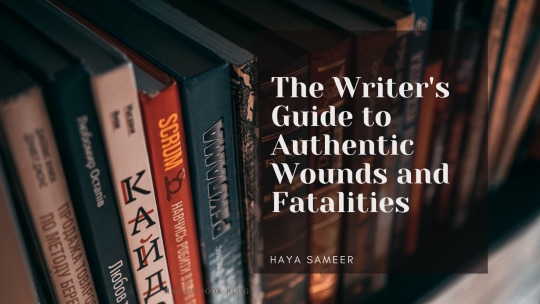
Writing fatal injuries in a story requires a delicate balance between realism and narrative impact. The portrayal of these life-altering events can evoke strong emotions in readers and shape the trajectory of your characters' journeys. In this blog, I will explore the intricacies of depicting fatal injuries in a manner that feels authentic, engaging, and respectful to the gravity of such circumstances. By understanding the nuances of fatal injuries, you will be equipped to craft compelling narratives that resonate with your readers.
Writing Fatal Injuries
When it comes to writing fatal injuries, it is crucial to approach the subject with care and accuracy. Fatal injuries carry immense consequences for your characters and can shape the trajectory of your story. By delving into the intricacies of portraying fatal injuries authentically, you can ensure that the gravity and impact of such events are effectively conveyed to your readers.
Choosing the right injuries for your story
Selecting the appropriate fatal injuries for your narrative involves considering various factors. Ask yourself: What purpose does this injury serve within the story? How does it affect the characters and the overall plot? Conduct thorough research to identify injuries that align with your story's context and resonate with the emotional journey of your characters.
For example, in a historical drama, you may research common fatal injuries during a particular era, such as battlefield injuries, diseases, or accidents prevalent at the time. In a crime thriller, you might explore the portrayal of fatal gunshot wounds or traumatic injuries resulting from violent encounters. By aligning the injuries with the context and themes of your story, you create a more immersive and believable experience for your readers.
Researching the mechanics of fatal injuries
To portray fatal injuries convincingly, it is essential to delve into the mechanics behind them. Understand the specific anatomical structures and systems involved, as well as the forces or mechanisms that can lead to fatal outcomes. Explore medical resources, consult experts if possible, and gather insights into the physiological and psychological implications of such injuries.
For instance, if your character suffers a fatal stab wound, research the anatomy involved, the potential organs affected, and the potential consequences such as internal bleeding or organ failure. By understanding the specific details and implications of the injury, you can describe the physical and emotional toll it takes on the character with greater accuracy and depth.
Depicting the immediate aftermath
When writing about fatal injuries, vividly describe the immediate aftermath to capture the intense emotions and physical realities. Consider the sensory details, the shock and disbelief experienced by characters, and the chaotic environment that often surrounds such events. Balancing realism with the needs of your story, create a scene that immerses readers and evokes empathy.
For example, if a character experiences a fatal car accident, you can depict the chaos at the scene, the character's disorientation, and the reactions of witnesses. Emphasize the sensory details such as the sound of screeching tires or the smell of burning rubber, creating a visceral experience for your readers.
Emotional and dramatic impact on the narrative
The impact of fatal injuries extends beyond the immediate moment. Explore the ripple effects on other characters, relationships, and the overall plot. Delve into the emotional responses, grief, guilt, anger, or determination that arises in the aftermath of loss. Utilize these emotional arcs to deepen character development and drive the narrative forward.
For instance, the loss of a loved one due to a fatal illness might lead to grief and strained relationships among the remaining family members. The emotional journey of a character grappling with guilt and seeking redemption after causing a fatal accident can become a central theme in your story. By delving into these emotional arcs and their consequences, you add depth and resonance to your narrative.
Writing Minor Injuries
While fatal injuries may capture our attention with their dramatic impact, it is equally important to pay attention to the portrayal of minor injuries in your writing. Minor injuries, though less severe, can still significantly affect your characters and contribute to the authenticity of your story. In this section, we will explore the art of depicting minor injuries, ensuring that they are not overlooked or trivialized. By delving into the nuances of minor injuries, you can add depth and realism to your characters' experiences.
Types of minor injuries to consider
When crafting your story, it is essential to consider a range of minor injuries that can occur. These injuries can include cuts, bruises, sprains, minor burns, or even minor fractures. Each type of injury carries its own unique characteristics, associated pain levels, and recovery processes. By understanding these distinctions, you can create accurate and believable depictions that resonate with your readers.
For example, a character who sustains a cut on their hand may experience sharp pain, the sight of blood, and the need for immediate first aid. On the other hand, a character with a sprained ankle may struggle with mobility, experience swelling, and require rest and care for a few days. By paying attention to these specific details, you can enhance the realism of your storytelling.
Conveying pain and discomfort
When writing about minor injuries, it is important to effectively convey the pain and discomfort experienced by your characters. Consider describing the sensation of pain, the throbbing or stinging feeling, and how it affects their daily activities or interactions. Showcasing the emotional impact of pain, such as frustration, irritation, or vulnerability, can deepen the readers' connection to the character's experience.
For instance, if a character suffers from a sprained wrist, you can describe the dull ache that persists, making simple tasks like typing or holding objects challenging. By capturing these small but significant moments, you immerse readers in the character's struggle and create a more realistic portrayal.
Balancing realism with narrative pace
While it is important to depict minor injuries realistically, it is also crucial to strike a balance with the overall pace and momentum of your story. Consider the significance of the injury within the larger context of your narrative. Some injuries may require more detailed attention and impact the plot, while others may serve as background elements. Adjust the level of detail and focus accordingly, ensuring that the portrayal of minor injuries aligns with the narrative's flow.
For example, a small cut on a character's finger may not require an extensive description unless it becomes infected or triggers an unexpected consequence. By aligning the portrayal of minor injuries with their narrative relevance, you maintain a consistent pace while still acknowledging their impact on your characters' lives.
Writing Bloodshed And Realistic Blood Loss
When writing about wounds and injuries, it is essential to consider the amount of blood loss your characters may experience. Realistic portrayal of bloodshed can enhance the authenticity of your scenes and immerse readers in the gravity of the situation. In this section, we will explore the factors influencing blood loss and techniques for accurately depicting it in your writing.
Understanding blood loss and its impact on the body
To authentically portray blood loss, it's crucial to have a basic understanding of how the human body responds to injury. Research the circulatory system and the role of blood in transporting oxygen and nutrients throughout the body. Consider the different types of blood vessels and their potential for bleeding when injured. This knowledge will help you create realistic scenarios and determine the appropriate level of blood loss for specific injuries.
Factors influencing blood loss in different injury scenarios
The amount of blood loss can vary depending on the severity and location of the injury. Factors such as the size of blood vessels, the rate of bleeding, and the body's ability to clot play a significant role. For example, a deep laceration in an artery will result in more substantial blood loss compared to a superficial cut on the skin. Consider these factors when describing injuries and their resulting bloodshed.
Techniques for accurately portraying blood loss in writing
There are several techniques you can use to convey the realistic impact of blood loss in your writing. Describing the color, consistency, and flow of blood can provide vivid imagery. You can also include physical symptoms such as dizziness, weakness, or fainting that may accompany significant blood loss. Additionally, consider the emotional response of your characters and how they react to the sight of blood or their own injuries.
By incorporating these techniques, you can create scenes that evoke a visceral response in readers and enhance the authenticity of your writing.
Bruises: Colors, Progression, and Pain
Bruises are a common result of injuries, and understanding how they form, change in color, and cause discomfort can greatly enhance the realism of your writing. By accurately describing bruises, you can bring depth to your characters' injuries and portray their healing process convincingly.
Understanding the stages and colors of bruises
Bruises go through distinct stages of color as they heal. Initially, they may appear red or purple due to the broken blood vessels beneath the skin. Over time, the color changes to blue, green, yellow, and eventually fades to a brown or yellowish hue. Understanding this color progression can help you accurately describe the age of a bruise and the healing process.
For example, a fresh bruise might be vivid purple, indicating recent trauma, while a fading bruise may have a yellowish tinge, suggesting that healing has begun. By incorporating these color details, you can add realism to your characters' injuries and track the passage of time within your narrative.
Depicting the progression of bruises over time
As bruises heal, they often change in appearance and size. Initially, a bruise may be small and localized, but it can gradually spread and become more extensive. Describing this progression can provide a sense of the healing process and the passage of time within your story.
For instance, a character who sustains a significant blow to the face may develop a bruise that starts as a small spot near the eye but expands to cover a larger area over the next few days. By accurately portraying the progression of bruises, you enhance the authenticity of your characters' injuries and their recovery.
Conveying the pain and sensitivity associated with bruises
Bruises can be painful, sensitive to touch, and affect a character's movement and daily activities. Describing the pain and discomfort experienced by your characters can create empathy and immerse readers in their physical ordeals.
Consider conveying the tenderness of a bruise when pressure is applied, the throbbing sensation, or the limitation of movement due to the pain.
Remember The Side Effects
Injuries, whether minor or severe, often come with a range of side effects that can significantly impact your characters' lives. These side effects can extend beyond the physical realm and encompass emotional, psychological, and social aspects.
Physical side effects
Injuries can have profound physical side effects that go beyond the immediate pain and discomfort. Consider the potential consequences such as limited mobility, impaired coordination, chronic pain, or the need for assistive devices like crutches or braces. Describing these physical side effects can add depth to your characters' struggles and provide a realistic portrayal of their healing journey.
For example, a character who sustains a leg injury may experience difficulty walking, require physical therapy, or have long-term complications that affect their day-to-day activities. By addressing these physical side effects, you create a more nuanced depiction of the aftermath of injuries.
Emotional and psychological side effects
Injuries can have a profound emotional and psychological impact on characters. They may experience fear, anxiety, trauma, or a loss of confidence. Consider how the injury affects their self-image, relationships, or mental well-being. Explore the emotional journey your characters undergo as they navigate the aftermath of their injuries.
For instance, a character who survives a near-fatal accident may develop post-traumatic stress disorder (PTSD) and struggle with recurring nightmares or panic attacks. By incorporating these emotional and psychological side effects, you can deepen the complexity of your characters and their responses to traumatic experiences.
Social implications and changes
Injuries can also lead to significant social changes for your characters. They may face challenges in their personal relationships, encounter stigma or discrimination, or experience changes in their roles or identities. Explore how the injury affects their interactions with others and their sense of belonging in the world.
For example, a character who sustains a facial injury may encounter judgment or stares from others, leading to self-consciousness or isolation. By addressing the social implications and changes resulting from injuries, you can create multi-dimensional characters and explore the impact of their injuries on their social dynamics.
By incorporating these various side effects into your writing, you bring depth and authenticity to your characters' experiences and showcase the wide-ranging impact of injuries.
Conclusion
Writing authentic wounds and fatalities requires attention to detail and a deep understanding of the physical, emotional, and psychological aspects involved. By following the guidelines and exploring the subheadings discussed in this guide, you can create compelling and realistic portrayals of injuries in your writing.
Remember to conduct thorough research on the specific injuries you want to depict, understanding their mechanics, symptoms, and potential outcomes. Consider the immediate and long-term effects on your characters, both physically and emotionally. Incorporate sensory details to immerse readers in the experience, describing the pain, bloodshed, colors of bruises, and the progression of healing.
Additionally, don't forget to address the side effects that injuries can have on your characters' lives. Explore the physical limitations, emotional struggles, and social implications that arise from their injuries. By delving into these aspects, you can create well-rounded characters and compelling narratives that resonate with readers.
I hope this blog on forging epic battles will help you in your writing journey. Be sure to comment any tips of your own to help your fellow authors prosper, and follow my blog for new blog updates every Monday and Thursday.
Looking For More Writing Tips And Tricks?
Are you an author looking for writing tips and tricks to better your manuscript? Or do you want to learn about how to get a literary agent, get published and properly market your book? Consider checking out the rest of Haya’s book blog where I post writing and publishing tips for authors every Monday and Thursday! And don’t forget to head over to my TikTok and Instagram profiles @hayatheauthor to learn more about my WIP and writing journey!
#hayatheauthor#haya's book blog#haya blogs#writers on tumblr#writer community#writer tools#writer blog#writer stuff#writer wednesday#writer tips#creative writing#writers of tumblr#writerscommunity#writeblr#writing community#writer spotlight#writer things#writing prompt#writing tools#writing stuff#writing#writing life#writing inspo#writing help#writing advice#writing inspiration#writing ideas#writing things#writing tip
4K notes
·
View notes
Note
If Sonic ever got stuck in Werefox form, what would happen?
I know this is technically not what you asked for- but I'm gonna use this as an excuse to draw Tails' first reaction to witnessing the start of a Super Full Moon transformation cycle.
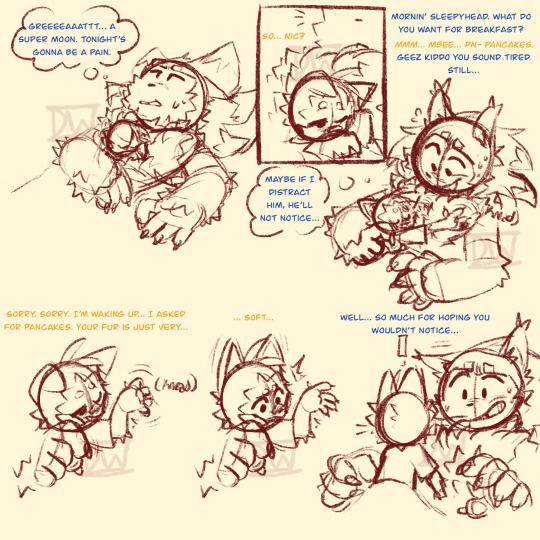
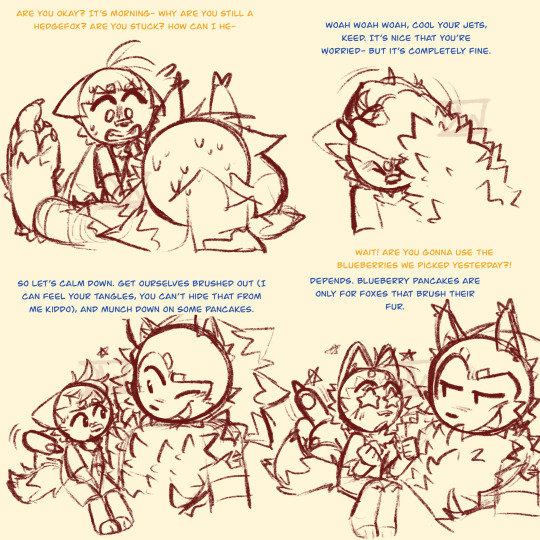
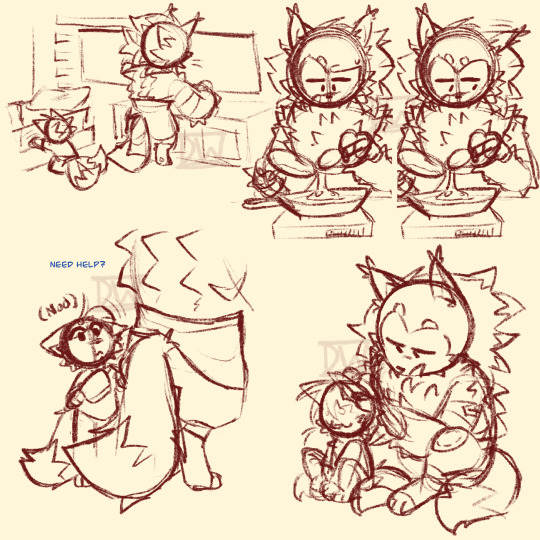
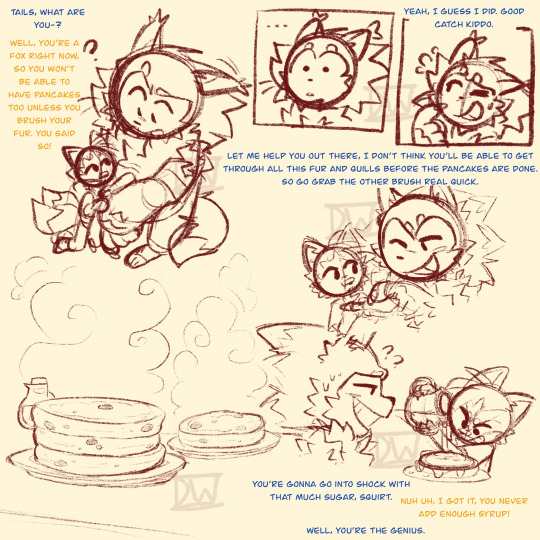
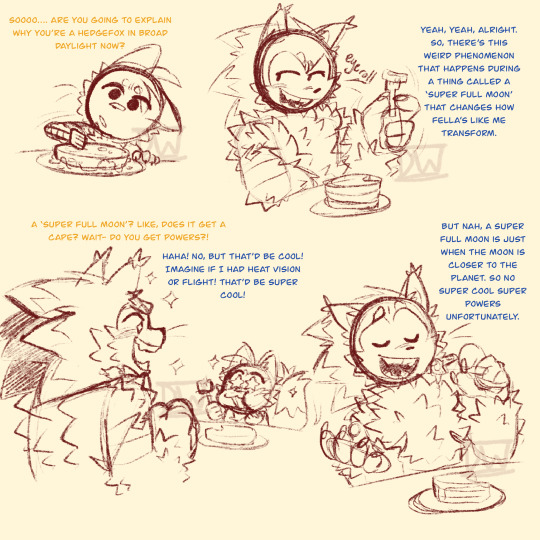
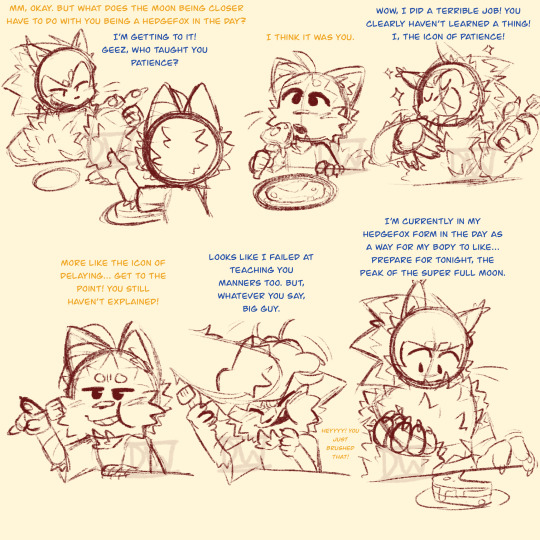
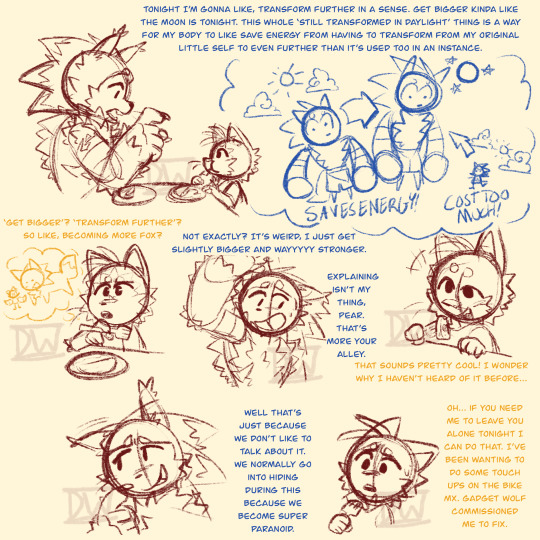
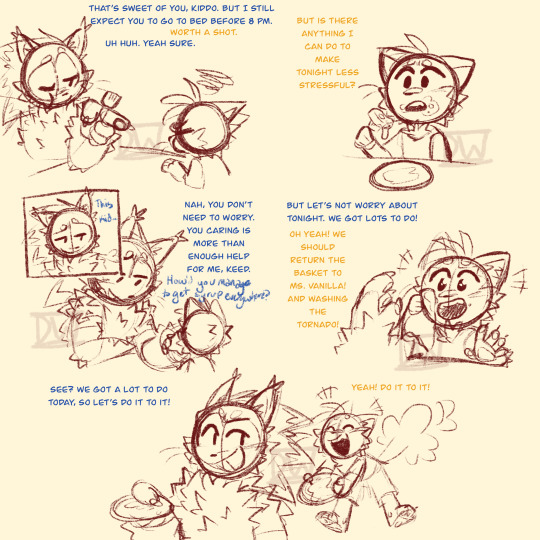
It's odd that there isn't a lot of stories where Sonic teaches Tails something. I know Tails is a genius, but he's like 3 here.
But yeah! Sonic does sometimes technically get 'stuck' in his Hedgefox form.
Part 2
#sonic the hedgehog#sonic the werehog#dadnic#(but he isn't aware of that yet)#miles tails prower#tails the fox#roadtrip!sonic au#sonic fanart#wholesome sonic and tails wednesday#This was gonna be uploaded on time- but these two just HAD to banter so much#I say that like I'm not the person who's writing them...#Coincidentally- tonight seems to be a full moon for me.
680 notes
·
View notes